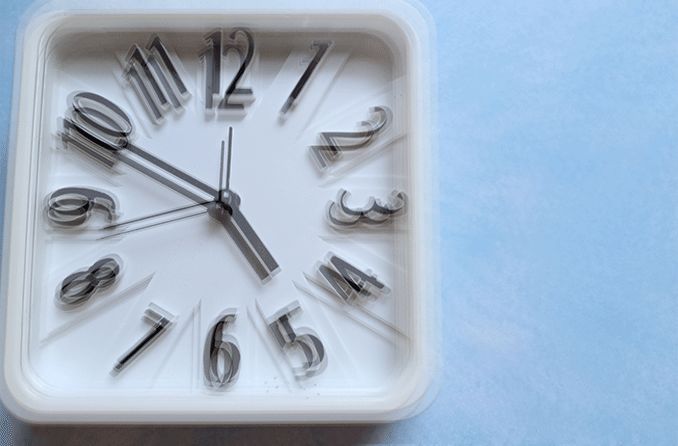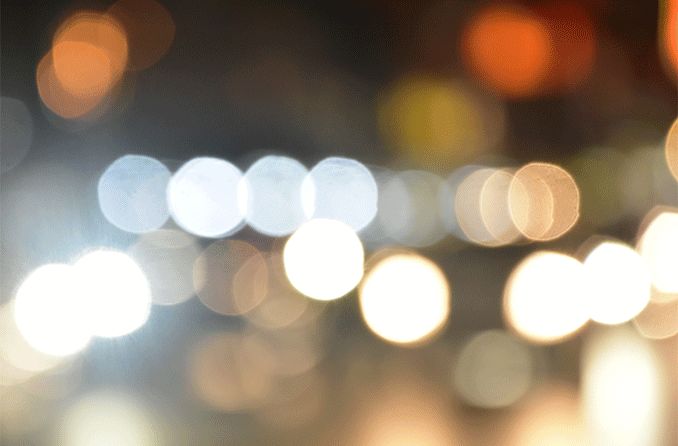Why do we see halos?
It’s not unusual to see a circle or starburst radiating from a light source when you look directly at it. However, constantly seeing halos may be a concern worth raising to your eye doctor. Halos around lights can be a sign of both mild or severe eye issues. These can range from an outdated lens prescription to a condition that requires emergency treatment.
Let your eye doctor or an ophthalmologist know if you suddenly start seeing halos, especially if they are accompanied by pain, redness, blurred vision or any other major symptoms. This could be due to an underlying condition that requires monitoring and treatment.
What causes halos around lights?
According to the American Academy of Ophthalmology, seeing halos around lights may be associated with the following conditions:
Some other causes may include:
Recovery from vision surgery such as LASIK or cataract surgery
Exposure to a chemical such as chlorine
Wearing an incorrect vision prescription
Corneal edema
Cataracts
There are many types of cataracts that can affect your vision in different ways. Cataracts that affect the back of the lens (known as posterior subcapsular cataracts) can cause you to have trouble reading in dim light. They can also interfere with your vision in brightly lit environments. These cataracts may also cause glare or halos around lights, especially at night time.
It’s important to have an eye exam every year to rule out conditions such as cataracts, and even more important if the condition runs in your family. Posterior subcapsular cataracts have been known to progress more quickly than other types of cataracts, which can lead to further vision problems.
Keratoconus
Keratoconus is a progressive eye condition that causes the naturally dome-shaped cornea to thin out over time. This thinning can lead to a cone-shaped bulge in the eye. This process can result in astigmatism, nearsightedness and severe vision impairment as time goes on.
Because the cornea is directly impacted by the condition, many of the symptoms are light related. This includes seeing halos around lights, light sensitivity, eye strain and trouble driving at night.
Depending on the stage and degree of keratoconus, it can be treated with corrective lenses. Some cases may require corneal cross-linking or a corneal transplant, however. There is no known cause for keratoconus. However, some research seems to indicate that an enzyme imbalance in the cornea could make it more vulnerable to oxidative damage.
Photokeratitis
Photokeratitis is a sunburn-like condition caused by too much exposure to ultraviolet (UV) rays. These rays can damage the eyes — especially the thin surface of the cornea.
The conjunctiva (which covers the surface of the eye and lines the inner eyelids) is also affected by the condition. Seeing halos around lights is one of the many symptoms associated with photokeratitis. Other symptoms may include pain, redness, blurred vision and more.
It’s critical to wear proper sun protection to prevent serious damage caused by photokeratitis (and its painful symptoms). Though the condition usually heals on its own, be sure to see an eye doctor if you experience symptoms that persist for longer than a few days.
Closed-angle glaucoma
Closed-angle glaucoma, also called angle-closure glaucoma or narrow-angle glaucoma, is a type of glaucoma that occurs when the iris is too close to the eye’s drainage angle. This causes eye pressure to rise very rapidly and can ultimately cause the drainage angle to be totally blocked. This is called an acute angle-closure attack and must be treated as an emergency to prevent blindness.
One critical symptom of acute angle-closure glaucoma is seeing rainbow halos or rings around lights. Contact your eye doctor immediately if you experience this or other symptoms such as:
Sudden blurry vision
Headache
Severe eye pain
Nausea or vomiting
Some develop closed-angle glaucoma slowly over time (known as chronic angle-closure glaucoma). This type of glaucoma doesn’t present any initial symptoms. In fact, many are unaware that they have the condition until an attack occurs.
In any case, it is crucial to see an eye doctor immediately to care for the condition.
Fuchs’ dystrophy
Fuchs’ dystrophy is a disease that causes fluid to build up in the cornea, making it swell, thicken and affect vision. Those who have Fuchs’ dystrophy may experience discomfort, cloudy vision and glare. Seeing halos around lights is also a common symptom.
The condition affects both eyes and can worsen over time. People may start developing the disease in their 30s and 40s, although many don’t show symptoms until their 50s or 60s. Medication can help treat the condition, but advanced cases may require a cornea transplant.
SEE RELATED: 10 warning signs of age-related eye problems
Pigment dispersion syndrome
Pigment dispersion syndrome (PDS) occurs when bits of the iris’s pigment (the substance that gives your eye its color) flake off. These bits and flakes can eventually wash into the eye’s drainage angle and cause eye pressure problems, which may lead to glaucoma.
Though there are some risks that come with PDS, many of those who have it do not experience symptoms. However, strenuous activity can cause some people with PDS to see halos or experience blurry vision.
Dry eye syndrome
Dry eye syndrome causes the surface of the eye to lose moisture, which can cause surface irregularities and affect the way light enters it. This can cause you to see glares and halos around light sources at night, especially when driving.
You may also experience pain, redness or a burning sensation with dry eyes in addition to visual symptoms. Dry eyes can be triggered by dry environments, allergies and even digital eye strain. Try using artificial tears to help combat the symptoms and speak to your eye doctor if they get worse.
Astigmatism
Astigmatism is a refractive error in which the cornea or lens is misshapen. The cornea and lens are responsible for filtering light and directing it to the retina. When one of them is imperfectly shaped, light cannot pass through properly.
Astigmatism can especially affect vision in dark environments and activities such as driving at night time. When the pupils widen to let in more light, that light is also passing through more surface area of the imperfectly shaped cornea or lens. You may notice halos around street lights or car headlights because of this.
SEE MORE: Astigmatism: Effects on light and night driving
Incorrect vision prescription
If you’re not wearing the correct lens prescription, you may notice things such as blurred vision, headaches and even halos around lights. Fortunately, getting an updated vision prescription may be all you need to stop these things from happening.
Be sure to contact your eye doctor if you notice changes in vision clarity, and get a comprehensive eye exam once a year to keep your prescription updated. An eye exam is also important to make sure you are not showing signs of any other serious vision problems that could be causing halos.
Chlorine (and other chemical) exposure
It’s easy to get exposed to chlorine during a swim in a pool treated with the chemical. Not only can this cause burning and irritation, it can also cause you to become sensitive to light and even see halos around bright lights.
This is due to the chemical effect on the tear film in the eyes. The tear film is a special, thin layer that coats the surface of the eye and keeps it clean and moistened. When you are exposed to chemicals such as chlorine, the moisture of the film can be destroyed. Eyes can become red, dry, irritated and sensitive to light, causing you to see halos.
That being said, it is critical to protect your eyes during a swim. Chlorine is irritating enough on its own, but bacteria left from bugs, environmental factors and fellow swimmers can also make its way into your eyes and cause irritation. If your exposure is high enough, it may even cause an infection such as conjunctivitis to occur.
Protect your eyes from harmful pool chemicals with goggles or by using artificial tears before and after a swim. You should also refrain from wearing contacts in the pool, as bacteria can become trapped under the lenses and lead to infection or other damage.
Vision surgery recovery
The recovery process after procedures such as laser vision surgery (LASIK) may include seeing halos around lights. This is somewhat common, but if you experience pain or other side effects, let your eye doctor know as soon as possible.
Other types of vision surgery, such as cataract surgery, may cause you to see halos during the healing process as well. During a cataract procedure, the natural lens of your eye is replaced with an artificial, custom intraocular lens (IOL). As you are getting accustomed to the new lens, you may see halos or starbursts around light sources.
Your eye doctor or surgeon will let you know what to expect before any procedure takes place. But you should always reach out to your doctor if you have any follow-up concerns or questions.
Corneal edema
Corneal edema is the medical name for swelling of the cornea. Various issues can cause the condition, including endotheliitis, Fuchs’ dystrophy and eye trauma. Reactions to certain eye drops and topical medications may also lead to corneal edema.
When the cornea becomes swollen, it can cause blurred or cloudy vision, light sensitivity or halos around lights. Corneal edema is not a life-threatening condition, but it could damage vision if not treated. It should be examined by a doctor as soon as possible to ensure that vision is taken care of and further complications are avoided.
What causes rainbow-colored halos?
If you experience rainbow-colored halos around lights, it could be due to a serious problem such as one of the following:
Foreign object in your cornea
Cataracts
Closed-angle glaucoma
Swelling of the eye’s lens due to diabetes
Should you experience halos with rainbow colors (especially accompanied with pain and blurred vision), contact an eye doctor as soon as possible. Each of these conditions can have a major impact on your vision if left untreated.
Treatment
Treating your vision for halos and starbursts depends on the underlying cause. Conditions such as glaucoma, cataracts and Fuchs’ dystrophy may all require surgical procedures. Less serious conditions like photokeratitis may only require over-the-counter pain relievers to heal.
Halos can also occur with incorrect vision prescriptions. This is easily corrected with a new pair of eyeglasses or contact lenses.
Talk to your eye doctor about what is causing you to see halos around light sources, as the solution can range from mild corrections to surgery.
SEE RELATED: How older drivers can improve their driving at night
Prevention
Can you prevent seeing halos around lights? Like treatment, the prevention for seeing halos around lights depends on what may cause them.
For example, if you have a condition such as dry eye syndrome, glaucoma or cataracts, it’s important to follow your doctor’s care instructions. Preventing flare-ups can help reduce symptoms like halos around lights.
Wearing eye protection in the sun is the best way to prevent photokeratitis from occurring and causing halos around lights. And wearing eye protection such as goggles in chlorine pools is the best way to protect eyes from being exposed to the chemical.
Maintaining a healthy diet and lifestyle can also help support eye health. This is especially important for those who have conditions such as diabetes.
When to see an eye doctor about halos
Often, seeing halos around lights is normal and nothing to worry about. There is no harm in calling your eye doctor if you are concerned about it, though. Definitely contact your eye doctor if you experience additional symptoms such as the following:
Eye pain
Vision impairment
Blurred vision, especially if it happens suddenly
Trouble seeing at night
Nausea or vomiting
If you recently had laser eye surgery, it is normal to see halos around lights during recovery. However, you should follow up with your eye care provider if symptoms persist.
Keep eyes healthy with routine exams
Halos around lights can be related to many eye issues, from a change in vision prescription to serious conditions such as glaucoma. Be sure to see an eye doctor once a year for a proper eye exam, which will help determine any changes in your vision.
Seeing your eye doctor for regular eye exams is also very important for the early detection of vision problems that may cause you to see halos. Whether mild (like a prescription update) or more serious (like medication or surgery), early treatment may prevent the problem from progressing.
Talk with your doctor about your symptoms regarding halos around lights. It could be a normal occurrence, but it could also be a sign of a condition that requires you to see your eye doctor more often if it’s not.










